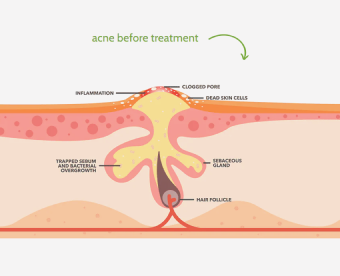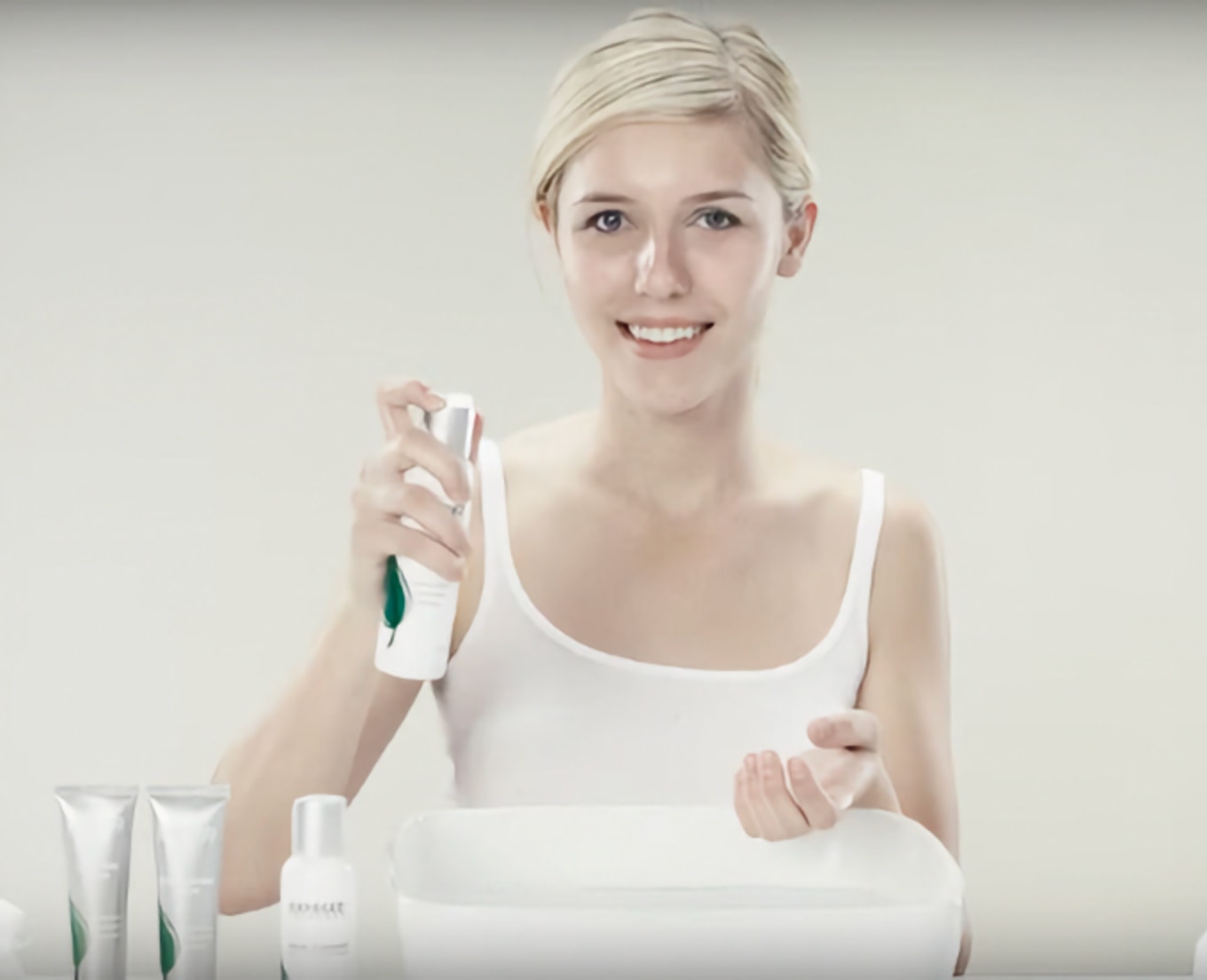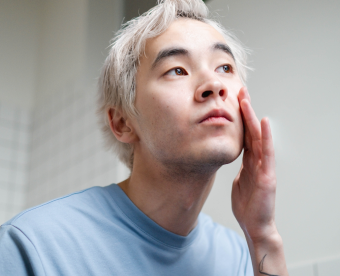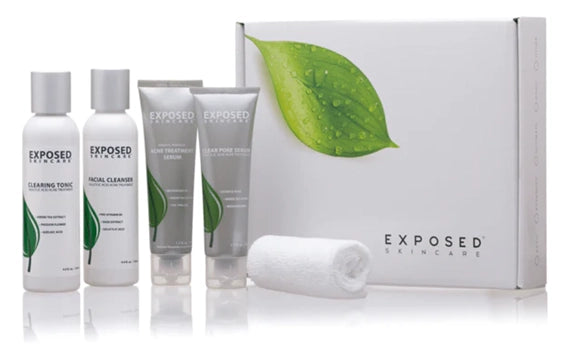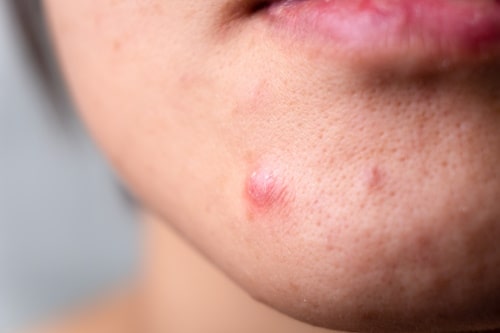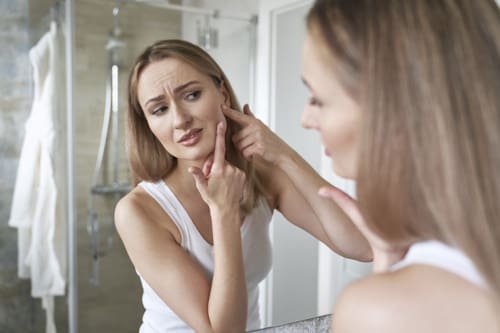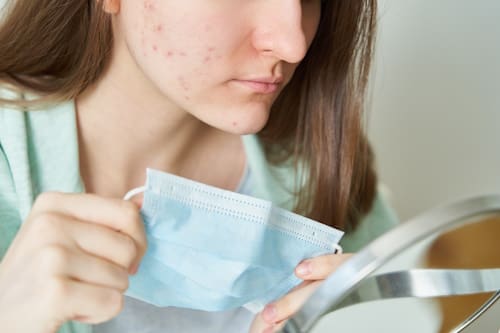Acne affects people of all ages and skin types. While acne can occur anywhere on the face or body, one of the most common areas is the forehead. Often neglected or underestimated, forehead acne can be uncomfortable and a confidence-killer.
This blog post explores the different types of forehead acne, their causes, and effective treatment options. Read on to get the perfect skin that you have always wanted.
Also read: How to choose the best acne treatment
Biggest Take-Aways:
- Understanding the types and causes of forehead acne is key to effective treatment and prevention.
- While forehead acne is often considered less severe, it can still significantly impact your well-being.
- Prevention is as important as treatment, and understanding triggers can help in effective management.
- Exposed Skin Care offers a comprehensive approach to effectively treating and preventing forehead acne.
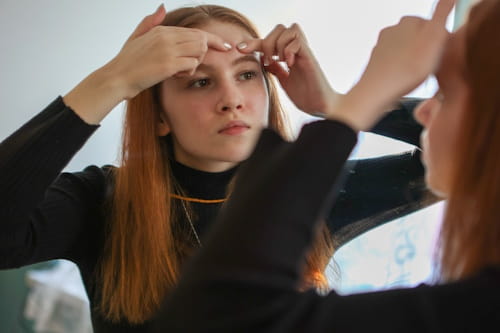
Types of Forehead Acne: A Deep Dive
Forehead acne comes in various forms, each with its own set of characteristics and treatment requirements. Understanding the different types of forehead acne is essential for effective treatment and prevention.
Mild Acne
Blackheads and Whiteheads
- Blackheads: Tiny black dots on the skin caused by a mixture of dead skin cells and sebum clogging the pores.
- Whiteheads: Small, white bumps that form when pores get clogged with excess oil and dead skin cells.
Treatment for Mild Acne
- Over-the-counter Treatments: Benzoyl peroxide or salicylic acid products can help treat and prevent mild acne.
- Regular Cleansing: Wash your face with a gentle cleanser to remove dirt and excess oil.
Moderate Acne
Papules and Pustules
- Papules: Small, red bumps that are sensitive to the touch.
- Pustules: Red bumps with white centers filled with pus.
Treatment for Moderate Acne
- Topical Retinoid: A form of Vitamin A that can treat acne by helping the skin to renew itself more quickly.
- Acne Cream: Over-the-counter acne creams with active ingredients like benzoyl peroxide can be effective.

Severe Acne
Nodules and Cysts
- Nodules: Larger, solid lumps beneath the skin’s surface.
- Cysts: Painful lumps filled with pus, a severe form of acne vulgaris.
Treatment for Severe Acne
- Prescription Acne Medication: Some severe or stubborn acne cases may require prescription medication.
- Severe Nodulocystic Acne: Such extreme forms often require a specialized treatment plan.
What Causes Forehead Acne?
Just as there are various types of acne you may encounter, multiple causes can contribute to acne on your forehead.
- Hormonal Fluctuations: Hormonal changes, particularly during adolescence, can worsen acne by triggering excess oil production in the sebaceous glands.
- Excess Oil and Dead Skin Cells: An accumulation of excess oil and dead skin cells can clog pores, leading to acne breakouts on your forehead.
- Hair Products: Pomade products on your hair or any hair products containing oils can also lead to acne, known specifically as pomade acne.
- Other Factors: These include stress, poor hygiene, environment, and diet.
How to Treat Forehead Acne Effectively
Treating acne effectively starts with identifying the specific type of acne you're dealing with. From over-the-counter treatments to targeted therapies, a range of options is available to treat acne on your forehead.
Over-the-Counter Solutions
- Benzoyl Peroxide: Effective for inflammatory acne, as it can kill acne-causing bacteria.
- Salicylic Acid: Helps to unclog pores and prevent acne.

- Retinoids: Available in over-the-counter creams and serums, useful for treating acne lesions.
Natural Remedies
- Tea Tree Oil: Has antibacterial properties that can kill acne-causing bacteria.
- Aloe Vera: Known for its soothing effects, it can help with redness and inflammation.
Specialized Treatments
- Chemical Peels: These treat acne scars and less severe forms of acne on the forehead.
- Light Therapy: Used mainly for inflammatory acne.
Preventive Measures to Keep Forehead Acne at Bay
Prevention is often the best cure. Here are some tips to prevent forehead acne and keep those annoying bumps at bay.
Daily Skincare Routine
- Cleanse: Wash your face twice daily to remove dirt, oil, and makeup.
- Exfoliate: Use a mild scrub to remove dead skin cells, but avoid over-exfoliating as it can make acne worse.

Lifestyle Changes
- Diet: Eating a balanced diet rich in fruits and vegetables can contribute to healthier skin.
- Exercise: Physical activity can improve blood circulation and help in the treatment and prevention of acne.
Product Choices
- Non-Comedogenic Products: These are designed not to clog pores, reducing the risk of developing acne.
- Hair Care: Opt for water-based or oil-free hair products to prevent pimples on your forehead.
Do Not Touch!
Avoid touching your forehead or popping pimples, as it can introduce bacteria and make acne worse.
Monitor Your Health
Sometimes, acne can be an indicator of underlying health issues. Keep an eye on any other symptoms you may be experiencing.
The Benefits of Using Exposed Skin Care for Managing Forehead Acne
Different types of acne can form on your forehead, from little bumps to raised red pimples. Using a comprehensive acne treatment system like Exposed Skin Care can make a significant difference in managing and preventing forehead acne effectively.
Here are the benefits of Exposed Skin Care:
- Comprehensive Solution: Exposed Skin Care offers a range of acne products, from cleansers to treatment serums, designed to tackle various forms of acne. Whether you're dealing with common or cystic acne, this product is tailored for you.
- Scientific and Natural Ingredients: Often, forehead acne is caused by a combination of factors like excess oil and dead skin cells or even caused by hair products. Exposed Skin Care products are formulated with a blend of advanced scientific ingredients and natural extracts that target the root causes of acne.
- Prevention and Treatment: Forehead acne can develop from various triggers, and the forehead is one area that is often associated with acne. Exposed Skin Care focuses on treating existing bumps on your forehead and preventing new pimples from developing.
- Dermatologist Approved: When dealing with more stubborn or severe cases of acne, it's essential to use products backed by dermatologists. Exposed Skin Care meets this criterion, ensuring effective and safe treatment.
By addressing the underlying causes that trigger acne, Exposed Skin Care offers a holistic approach to managing acne anywhere on your face, not just your forehead.
Conclusion
Understanding forehead acne's different types and causes is crucial for effective treatment and prevention. From understanding how acne forms to recognizing what specifically causes acne on your forehead, awareness is the first step in successful management.
Forehead acne is considered less severe on the forehead than anywhere else on your face for many people. However, it's important not to underestimate the psychological and physical impact of persistent bumps on the forehead. Acne involves a range of causes, from hormonal changes to lifestyle factors like diet and stress.
Preventing forehead acne involves recognizing certain triggers that lead to developing pimples. Knowing these triggers can significantly help in managing and preventing future outbreaks. This is where a comprehensive approach comes in handy.
Products like Exposed Skin Care offer a multi-step process that treats existing pimples and focuses on preventing new ones. The effectiveness of such products often lies in their formulation, which targets the root causes, whether it's excess oil, dead skin cells, or external triggers like hair products.
In summary, a targeted treatment and prevention approach can make a difference. Considering the various types of forehead acne that people can develop, opting for a comprehensive treatment like Exposed Skin Care can be a game-changer in your skincare routine.
FAQs
What types of forehead acne are commonly seen?
Forehead acne can range from mild forms like blackheads and whiteheads to more severe forms like cystic acne.
What causes acne on the forehead?
Various factors, including hormonal changes, excess oil, and even hair products, can contribute.
Is forehead acne considered to be less severe?
Forehead acne is often considered less severe than acne on other parts of the face but should not be underestimated.
What can trigger the development of pimples on the forehead?
Common triggers include hormonal fluctuations, stress, and using certain hair products that may clog pores.
How can I treat and prevent forehead acne effectively?
A comprehensive treatment like Exposed Skin Care can effectively treat existing acne and prevent new bumps.

